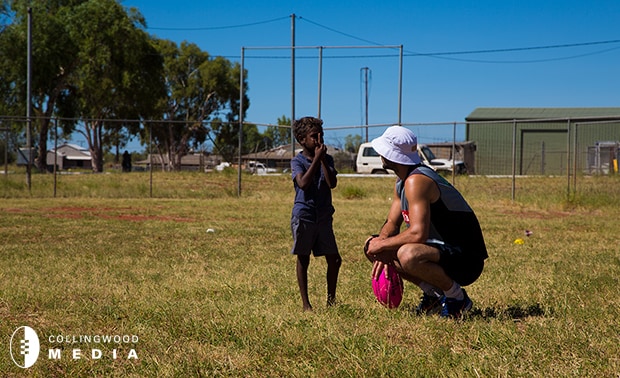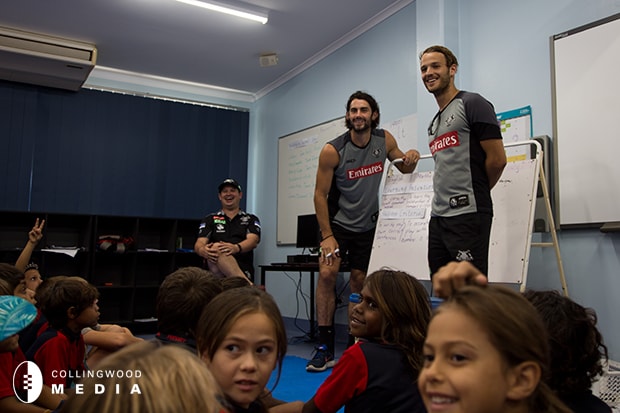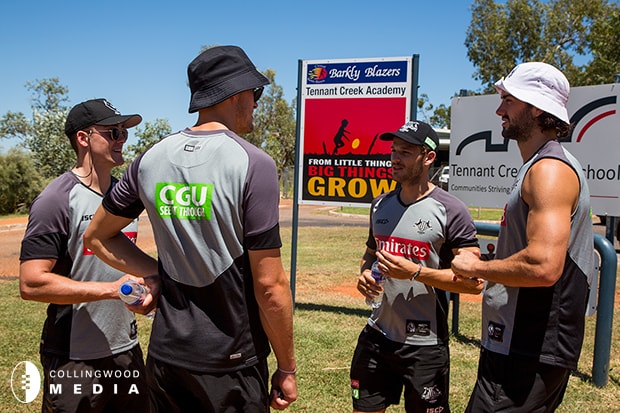
Collingwood Media is excited to present the first in a series of occasional columns from rising ruckman Brodie Grundy. In his first piece, Grundy discusses his life-changing pre-season trip to the Northern Territory and discusses the issue of football as a vehicle for hope.
Dream big, laugh lots.
The Australian Football League is undoubtedly a business. The game of Australian Football, though, is so much more. It is vitally human and beneath the cloak of its corporate identity an earthier, richer creation.
If you move beyond the metrics of commercial success; ticket sales, membership numbers and TV viewership, there is a place where glorious intangibles exist – gratitude, spirit and hope, for example.
When I consider my life in football, or more precisely the education I have received in it, it is my exposure to these ideals that have had the most influence on the person I am beyond the boundary.
My trip to the Northern Territory with Collingwood for a community camp in February this year was a part of our commitment to develop football programs in remote indigenous communities. I arrived thinking that I would be the one to pass on knowledge and expertise. I left, four days later, as the one profoundly wiser for the experience.
The impoverished conditions of the communities in the Barkly Region, (which spans hundreds of kilometers across rural Northern Territory) are confronting.
Ali Currung is a place where stray dogs follow kids to school and rubbish blights the red, sun burnt tracks. The kids I met at Ali Currung, a community three hours north of Alice Springs, looked like they had been pulled out of a bush backwards. Their hair was messy, the clothes they wore were either too big or too small and had stains of ochre.
These kids were also refreshingly real, cheeky and charismatic. Characteristics I think have something to do with the fact that the communities in which they live are detached from the materialism and consumerism that you and I know.
There is very little ego and their lives are simple - bare feet kinda simple. In my short exchange with the people of Ali Currung, I became the student.
They taught me about the importance of gratitude and the insignificance of material goods (they laughed when my new Giorgio Armani Sunglasses broke). Above all they taught me how to live in the moment and be thankful for it.
The next lesson came at the Tennant Creek Primary School. I was there for a classroom chat and had no idea what I was going to talk to the year sevens about. I still had no concrete topic to discuss with them until something caught my eye as I walked into the classroom. It was a three-part drawing of a person.
The first person had a red bubble in the head, the second had a similar shaped bubble in the chest and the third person simply had a red aura outlining it. The description that followed read - “Strong Mind, Strong Heart, Strong Spirit”.
It was this illustration that formed the basis of my classroom discussion. I was told that the figures represented the values of the school. Simple and yet deeply worthy, it struck me that there was a parallel between what this school of 100 children in the middle of the Northern Territory was teaching and the values we (as a playing group) have discussed at the Holden Centre.
“Strong Mind” - to make the right decisions. “Strong Heart” - to be courageous and stand up for what you believe in. “Strong Spirit” - to remain true to yourself which, in Tennant Creek, is also about not forgetting the land or place from which you come.
It was the “Strong Spirit” message that resonated with me most. Bound up in the notion of spirit is the idea that a good moral compass does not discriminate and exists anywhere a kind heart does.
Somewhere in there, too, is the realisation that you can be true to yourself always, whether you play on the MCG or happen to be seated in the front row of the year seven classroom at Tennant Creek Primary School.
I found the conditions in which some of the children live to be frightening. I was told, and believe, that a cycle of impoverishment exists that is very difficult for children caught in the cycle to break from.
Through no fault of their own, their lives will be shaped by the troubled pasts of their parents who, in their own way, are also victims of the cycle.
Intergenerational despair, often fuelled by drug and alcohol abuse, coupled with a lack of education and questionable funding priorities, will, in many cases, lead to disengagement and self-destruction.
We saw lots of young children roaming the streets, apparently free from a compulsion to attend school, because education is not seen as a priority by many.
With football programs acknowledging this, it is a requirement for many boys and girls that they maintain an 80 per cent attendance record at school to stay involved in the football programs they dearly love.
Interestingly enough, at the Tennant Creek Primary School attendance records had been at an all-time high in the week leading up to our visit.
Coincidence or not, it was clear to see the impact that the game, especially at AFL level, has on the Tennant Creek community.
In these parts, the game is used as a mechanism to generate purpose among its young people. It is also a vehicle to drive education and employment outcomes that, hopefully, will break the oppressive cycle many of them face.
The question of why is fascinating. And the answer is simple: it is a dream for many of these Indigenous children to play AFL football, something wonderful, joyous, and pure for them to hold on to.
I can now see just how important and influential current Indigenous AFL players are to this world of wonder. They are the dream made real, something told to me in a conversation I had with an inmate at the Barkly Work Camp (low-security prison).
As we chatted, he explained that when Indigenous people from the region make it to the AFL they don’t only receive admiration. They create hope.

Grundy: How football can provide hope
In the first of his occasional series as a Collingwood Media columnist, Brodie Grundy shares how his Northern Territory experience taught him the importance of football as a vehicle for hope.


